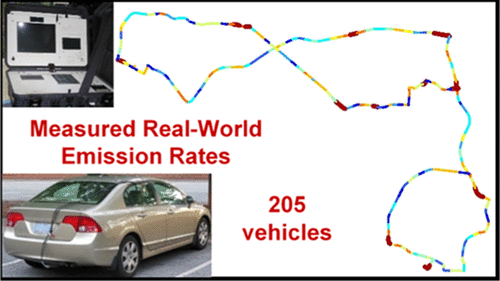当前位置:
X-MOL 学术
›
Environ. Sci. Technol.
›
论文详情
Our official English website, www.x-mol.net, welcomes your
feedback! (Note: you will need to create a separate account there.)
Geospatial Variation of Real-World Tailpipe Emission Rates for Light-Duty Gasoline Vehicles.
Environmental Science & Technology ( IF 10.8 ) Pub Date : 2020-06-25 , DOI: 10.1021/acs.est.0c00489 Tanzila Khan 1 , H Christopher Frey 1 , Nikhil Rastogi 1 , Tongchuan Wei 1
Environmental Science & Technology ( IF 10.8 ) Pub Date : 2020-06-25 , DOI: 10.1021/acs.est.0c00489 Tanzila Khan 1 , H Christopher Frey 1 , Nikhil Rastogi 1 , Tongchuan Wei 1
Affiliation

|
Spatial variability in real-world on-road tailpipe light-duty gasoline vehicle nitrogen oxides, hydrocarbon, carbon monoxide, and carbon dioxide emission rates, the locations of emissions hotspots, and factors that explain spatial variability are quantified. A sample of 205 vehicles were measured on four predefined round-trip study routes using Portable Emission Measurement Systems. The trips on each route were divided into segments, averaging 1/4 mile in length. Segment-average emission rates were estimated based on measured 1 Hz emission rates. Emission hotspots are defined as segments with ≥90th percentile of segment-average emission rates. The hotspots have average emission rates 2–4 times greater, depending on the pollutant, than other segments. Hotspots are of heterogeneous characteristics including road attributes and vehicle activity metrics. For example, some hotspots were on arterial roads with an upstream signalized intersection and positive road grade, whereas some hotspots were on interstates with positive grade. Vehicle activity metrics, including average vehicle specific power and relative positive acceleration, help identify the hotspots. To reliably identify a fleet-average hotspot, data are needed for at least 36–130 vehicles, depending on the pollutant.
中文翻译:

轻型汽油车实际尾气排放率的地理空间变化。
定量分析了现实世界中公路排气管轻型汽油车的氮氧化物,碳氢化合物,一氧化碳和二氧化碳的排放速率,排放热点的位置以及解释空间变异性的因素。使用便携式排放测量系统在四个预定的往返研究路线上测量了205辆汽车的样本。每条路线上的行程均分为多个部分,平均长度为1/4英里。根据测得的1 Hz发射速率估算分段平均发射速率。排放热点定义为分段平均排放率≥90%的分段。根据污染物的不同,热点的平均排放量是其他部分的2-4倍。热点具有不同的特征,包括道路属性和车辆活动指标。例如,一些热点位于具有上游信号交叉口且道路坡度为正的主干道路上,而一些热点位于道路坡度为正的州际公路上。车辆活动指标(包括平均车辆特定功率和相对正加速度)有助于识别热点。为了可靠地确定车队平均热点,至少需要36-130辆车的数据,具体取决于污染物。
更新日期:2020-07-21
中文翻译:

轻型汽油车实际尾气排放率的地理空间变化。
定量分析了现实世界中公路排气管轻型汽油车的氮氧化物,碳氢化合物,一氧化碳和二氧化碳的排放速率,排放热点的位置以及解释空间变异性的因素。使用便携式排放测量系统在四个预定的往返研究路线上测量了205辆汽车的样本。每条路线上的行程均分为多个部分,平均长度为1/4英里。根据测得的1 Hz发射速率估算分段平均发射速率。排放热点定义为分段平均排放率≥90%的分段。根据污染物的不同,热点的平均排放量是其他部分的2-4倍。热点具有不同的特征,包括道路属性和车辆活动指标。例如,一些热点位于具有上游信号交叉口且道路坡度为正的主干道路上,而一些热点位于道路坡度为正的州际公路上。车辆活动指标(包括平均车辆特定功率和相对正加速度)有助于识别热点。为了可靠地确定车队平均热点,至少需要36-130辆车的数据,具体取决于污染物。











































 京公网安备 11010802027423号
京公网安备 11010802027423号